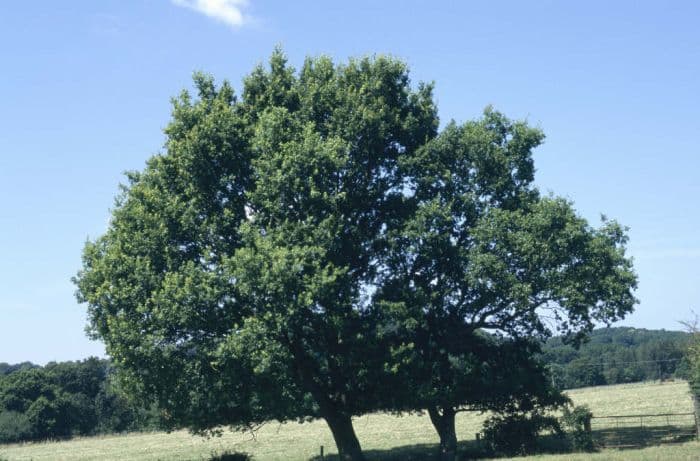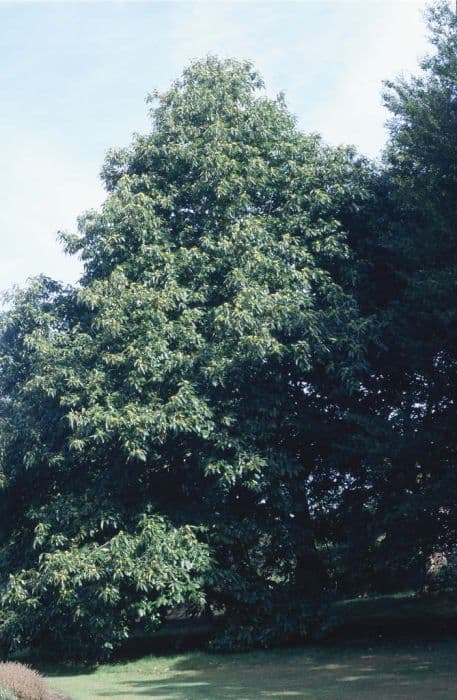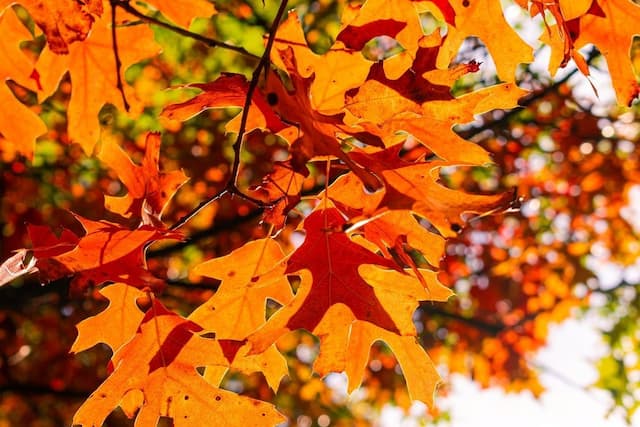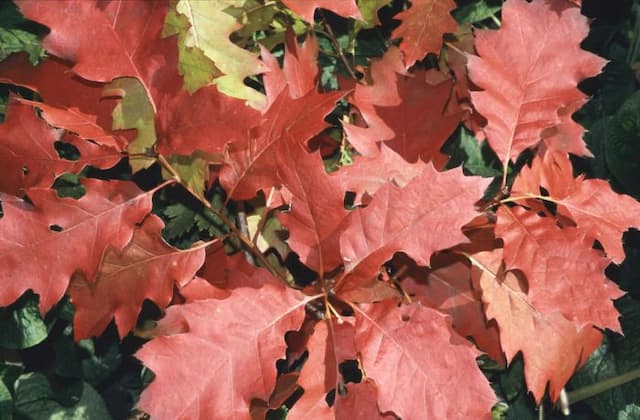English Oak Quercus robur

ABOUT
Quercus robur, commonly known as the English oak, is among one of the most iconic trees with its strong and sprawling presence. This tree is noted for its robust and rugged trunk, which has a deeply furrowed, grayish-brown bark that gives it a craggy look. The branches are stout and begin quite low on the trunk, extending outwards to form a wide, rounded crown that is typical of the species. The leaves of the English oak are distinctive, with a classic lobed shape that is easily recognizable. Each leaf is broad and has multiple lobes with rounded tips, and the overall shape is somewhat oblong. During the growing season, the leaves are a vibrant green that turns to rich shades of yellow and brown before they fall in the autumn. Another characteristic feature is the acorn, which is the fruit of the English oak. These nuts are held in small, scaly cups and typically take two years to mature. They are oval in shape and are a favorite food for many forms of wildlife. However, I will refrain from mentioning the specific size measurements for the English oak, as requested.
About this plant
 Names
NamesFamily
Fagaceae.
Synonyms
English Oak, Pedunculate Oak, French Oak, European Oak, Carvalho Alvarinho.
Common names
Quercus pedunculata, Quercus robur var. brutia, Quercus robur var. pedunculata, Quercus robur var. slavonica, Quercus robur var. robur, Quercus robur f. fastigiata, Quercus robur f. pendula, Quercus robur f. tortuosa, Quercus robur f. pyramidalis, Quercus robur f. concordia, Quercus robur f. filicifolia, Quercus robur f. argenteovariegata, Quercus robur f. atropurpurea, Quercus robur f. umbraculifera, Quercus robur f. fastigiata.
 Toxicity
ToxicityTo humans
The common name for Quercus robur is the English oak. Generally, the English oak is not poisonous to humans. However, the acorns and young leaves of the oak tree can contain tannic acid, which in large quantities can cause stomach upset, kidney damage, and other digestive disturbances if consumed. It is rare for people to consume enough of the acorns or leaves to cause serious poisoning, but care should be taken to avoid ingesting large amounts.
To pets
The English oak, or Quercus robur, can be toxic to pets, particularly dogs, if they ingest a large number of acorns or leaves. The tannins in the plant can cause gastrointestinal upset, leading to symptoms such as vomiting, diarrhea, abdominal pain, or constipation. In severe cases, ingestion of large quantities can result in kidney damage or other complications. Pets showing symptoms of oak poisoning should be taken to a veterinarian for evaluation and treatment.
 Characteristics
CharacteristicsLife cycle
Perennials
Foliage type
Deciduous
Color of leaves
Green
Height
70 feet (21 meters)
Spread
50 feet (15 meters)
Plant type
Tree
Hardiness zones
4-8
Native area
Europe
Benefits
 General Benefits
General Benefits- Wildlife Habitat: Provides a home and food source for birds, insects, and other animals.
- Longevity: Can live for hundreds of years, offering extended ecological benefits.
- Shade: Large canopy offers cooling shade which can reduce energy costs in urban areas.
- Aesthetic Value: Adds beauty to landscapes with its majestic form and vibrant autumn colors.
- Soil Stabilization: Extensive root systems help prevent soil erosion.
- Carbon Sequestration: Absorbs and stores carbon dioxide, helping to mitigate climate change.
- Recreational Space: Mature trees can create natural gathering spaces in parks and gardens.
- Biodiversity Support: Supports a wide range of flora and fauna, enhancing ecosystem diversity.
- Seasonal Interest: Offers changing scenery with its cycles of growth, flowering, and fruiting.
- Cultural Significance: Holds historical and cultural importance in many regions, often associated with strength and endurance.
 Medical Properties
Medical Properties- Anti-inflammatory: Extracts from Quercus robur, commonly known as the English oak, contain tannins which have shown anti-inflammatory properties.
- Astringent: The high tannin content of the bark is used for its astringent qualities, which can help in reducing bleeding and diarrhea.
- Antiseptic: Oak bark has antiseptic properties, making it useful for treating wounds and infections.
- Anti-diarrheal: Due to its astringent effects, oak bark is traditionally used to treat diarrhea.
- Phlebotonic: Oak bark is also said to strengthen blood vessels and has been used to treat varicose veins and hemorrhoids.
 Air-purifying Qualities
Air-purifying QualitiesThis plant is not specifically known for air purifying qualities.
 Other Uses
Other Uses- Tanning Leather: The bark of the Quercus robur, also known as the English oak, contains high levels of tannins which have traditionally been used in the leather tanning industry to make durable leather.
- Woodworking: The hardwood from the English oak is highly valued for making furniture, flooring, and veneers due to its strength, durability, and attractive grain.
- Wine and Spirits Barrels: English oak wood is used in the manufacture of barrels for aging wines and spirits such as whiskey, where it imparts complex flavors to the aged liquor.
- Beekeeping: The tree provides a robust habitat for bees, with its flowers serving as a source of pollen and nectar, thus helping in honey production.
- Dye Production: The bark and galls (abnormal growths) produced by the English oak can be used to produce natural dyes for textiles in shades of brown and black.
- Ink Making: Traditional ink can be made from the galls of the English oak, especially when combined with iron salts, producing a durable and long-lasting black ink.
- Shipbuilding: Historically, English oak was extensively used in shipbuilding due to its resistance to rot and the structural strength it provided to wooden ships.
- Mushroom Cultivation: The English oak can serve as a host for fungi cultivation, including edible species such as the oak bracket mushroom, which can grow on the tree's trunk.
- Wildlife Habitat: The tree is a key species in woodland ecosystems, providing habitat and food for a diverse range of wildlife including birds, squirrels, and insects.
- Historical Symbolism: English oak is a national symbol of strength and endurance in England, often associated with historical events and figures, and used in heraldry and civic emblems.
Interesting Facts
 Feng Shui
Feng ShuiThe English Oak is not used in Feng Shui practice.
 Zodiac Sign Compitability
Zodiac Sign CompitabilityThe English Oak is not used in astrology practice.
 Plant Symbolism
Plant Symbolism- Strength and Endurance: The English Oak, as Quercus robur is commonly known, symbolizes strength and resilience, likely due to its hardy nature and the fact that it can live for hundreds of years.
- Heritage and Ancestry: In many cultures, the English Oak is seen as a connection to the past and a way to honor one’s lineage, possibly because of its long lifespan and its place in local history and folklore.
- Nobility: The tree is often associated with nobility, with many old English estates boasting large oaks, reflecting the status and grandeur of the owners.
- Wisdom: The vast age and stature of the English Oak also contribute to its association with wisdom, as it stands as a silent witness to the passage of time.
- National Pride: In England, the English Oak is a symbol of national pride, being an emblematic part of the country's landscape and history.
 Water
WaterThe English Oak, commonly known as the Quercus robur, requires moderate watering. It is best to water this tree deeply and infrequently, providing it with about 1 to 1.5 inches of water weekly during dry periods. Young trees will benefit from being watered every 7 to 10 days during their first couple of seasons to establish a deep root system. Mature trees, on the other hand, generally only need additional watering in prolonged dry spells. When watering, aim to moisten the soil around the tree to a depth of 12 to 18 inches, which may equate to around 15 to 20 gallons, depending on the soil type and weather conditions.
 Light
LightThe English Oak thrives in full sunlight. It's important to plant it in a spot that receives at least six hours of direct, unfiltered sunlight each day. The most ideal location would allow for morning sunlight and some shade during the hottest part of the afternoon, though mature trees are tolerant of full sun throughout the day.
 Temperature
TemperatureThe English Oak can withstand a wide range of temperatures, from well below freezing up to 100 degrees Fahrenheit; however, it grows best in temperatures between 50 and 65 degrees Fahrenheit. Mature trees are very hardy and can survive winter cold down to -30 degrees Fahrenheit, making them suitable for various climate conditions.
 Pruning
PruningPruning the English Oak is mainly done to remove dead or diseased branches, to thin the crown allowing light and air to penetrate, and to remove any growth that may pose a hazard. The best time to prune is during the dormant season, typically late winter before the spring growth starts. For young trees, it's important to prune annually to establish a strong structure, while mature trees may be pruned every 3 to 5 years as necessary.
 Cleaning
CleaningNot needed
 Soil
SoilThe English Oak (Quercus robur) thrives best in well-drained, loamy soil with a pH ranging from slightly acidic to neutral, around 4.5 to 7.0. A mixture of two parts loam, one part sand, and one part compost or well-rotted manure will provide the nutrients and drainage the tree needs.
 Repotting
RepottingEnglish Oak trees (Quercus robur) seldom need repotting as they are typically grown in the ground due to their large size. If started in containers, they should be planted out when young, usually after 2-3 years.
 Humidity & Misting
Humidity & MistingEnglish Oak (Quercus robur) is adaptable to outdoor humidity levels and does not have specific humidity requirements for healthy growth, making it versatile in various climates.
 Suitable locations
Suitable locationsIndoor
Not suitable for indoor growth; English Oak requires outdoor space.
Outdoor
Plant in well-draining soil with full sun exposure.
Hardiness zone
4-8 USDA
 Life cycle
Life cycleQuercus robur, commonly known as the English oak or pedunculate oak, begins its life as an acorn, which, once germinated, slowly develops into a sapling. The sapling enters a lengthy juvenile phase, during which time it establishes a strong root system and starts to grow in height and girth over several years. As it matures into an adult tree, the English oak develops a broad crown and begins flowering, producing both male catkins and female flowers on the same tree. Following pollination, usually by wind, the fertilized flowers develop into acorns which fall to the ground in autumn. These acorns serve as the means of reproduction and can give rise to new oak saplings if they land in suitable conditions. An English oak can live for centuries, during which time it continues this cycle, contributing significantly to its ecosystem by providing habitat and food for a wide range of wildlife.
 Propogation
PropogationPropogation time
Spring-Early Summer
Propogation: Quercus robur, commonly known as the English Oak, is often propagated through the collection and sowing of acorns. The best time for collecting acorns for propagation is in the autumn, soon after they have fallen to ensure they are fresh and have not been compromised by pests or disease. The acorns are typically sown immediately since they lose viability quickly when dry. To propagate by acorns, one must select healthy specimens and plant them 1 to 2 inches deep in a mixture of soil and compost. It is imperative to keep the soil moist but not waterlogged as the acorns germinate and develop into seedlings. These seedlings can then be grown in a sheltered nursery area for several years before being transplanted to their final location. This method of propagation maintains the genetic diversity of the species, as each acorn can produce a genetically unique oak tree.









